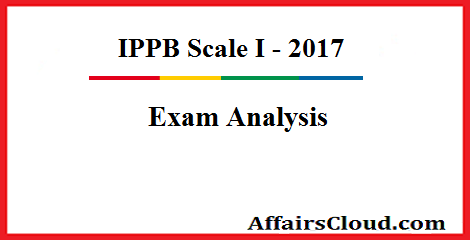Hello Readers,
IPPB Scale I Prelims Exam was over across India. The cutoff will be same for all states. Lets see today’s exam analysis.
The Overall level of the exam is easy
Here we are posting the complete exam review section wise.
| Section | Total Ques. | Max. Marks | Level of Difficulty | Good Attempts |
| Quant | 35 | 35 | Easy to Moderate | 18-22 |
| Reasoning | 35 | 35 | Easy | 28-32 |
| English | 30 | 30 | Easy to Moderate | 16-20 |
Quant Section:-
Quant section was easy to moderate.
- Data Interpretation – 2 sets (Line Graph, Table DI)
- Approximation – 5 Question(Easy to Moderate)
- Quadratic Equation– 5 questions
- Number Series – 5 questions
- 10 Questions from other topics including Partnership, Time and Work, SI/CI, Averages, Boat & Stream, Ages, Profit/Loss, Mixture n Alligation, Probability etc
Reasoning Section:-
Reasoning section was easy.
- Puzzles/Seating Arrangements –Circular Arrangement, Linear Arrangement, Floor Puzzle
- Coding & Decoding– 5 questions
- Syllogism – 5 questions
- Inequality – 5 questions
- Miscellaneous – 5 questions
English Section:-
English section was moderate
- Reading Comprehension – 10
- Spotting Errors – 10
- Cloze Test – 10
Questions asked in Exams:
Number Series Question:
- 180 191 193 203 206 215 ?
- 418 208 102 48 ? 5
- 153 155 160 170 187 ?
- 3 1.5 1.5 3 12 ?
- 3 4 9 28 ?
Cloze Test :
THE capital’s “airpocalypse”, the choking smog that descended on Beijing in the winter of 2012-13, galvanised public opinion and spooked the government. The strange thing is, though, that information about air pollution—how extensive it is, how much damage it does—has long been sketchy, based mostly on satellite data or computer models. Until now.
Responding to the outcry, the government set up a national air-reporting system which now has almost 1,000 monitoring stations, pumping out hourly reports on six pollutants, including sulphur dioxide, ozone and (the main culprit) particulate matter less than 2.5 microns in diameter, or PM2.5. These are tiny particles which lodge in the lungs and cause respiratory disease. The six are the main cause of local pollution but have little to do with climate change, since they do not include carbon dioxide, the main greenhouse gas. Scientists from Berkeley Earth, a not-for-profit foundation in America, have trawled through this recent cloud of data for the four months to early August 2014, sieved out the bits that are manifestly wrong (readings where the dial seems to be stuck, for instance) and emerged with the most detailed and up-to-date picture of Chinese air pollution so far.
In this section
Packing up the suitcase tradeMapping the invisible scourgeInferno
Reprints
Pollution is sky-high everywhere in China. Some 83% of Chinese are exposed to air that, in America, would be deemed by the Environmental Protection Agency either to be unhealthy or unhealthy for sensitive groups. Almost half the population of China experiences levels of PM2.5 that are above America’s highest threshold. That is even worse than the satellite data had suggested.
“Don’t Worry about the Results, Keep learning”





